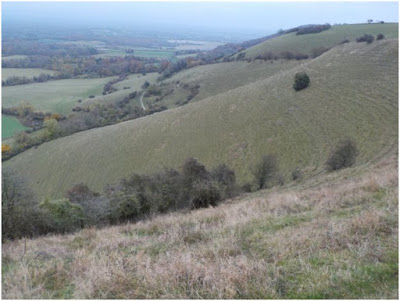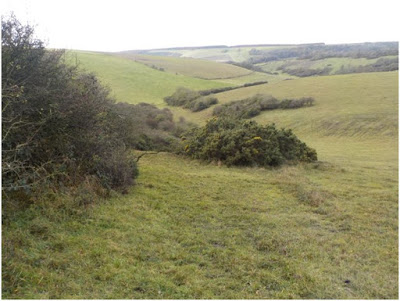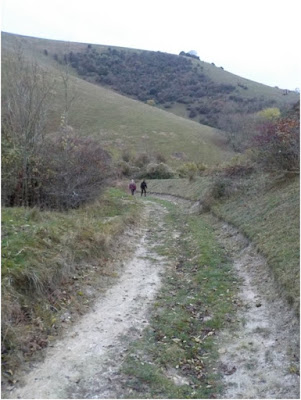Displays its Hostility to Publicly Owned and Controlled Assets
 |
| Plumpton Hill – FOR SALE |
Those who believe it
is better having a ‘Labour’ council, despite it being dominated by New Labour, should think again. It is clear that
the current administration is seeking to sell off to private landlords,
with the Duke of Devonshire’s Estates having first option, the 12,500 of Downland that the Council owns. Ironically, what a Conservative Brighton Council
purchased in the 1920’s and 1930’s a ‘Labour’ Council will privatise
today.
December a Council committee will take the decision as to whether or not to begin
the process of privatisation.
This was a process that was initiated by the previous Green
administration which also bought into neo-liberal free market economics. If the sell-off goes
ahead it will have devastating implications for the future of the National
Park.
exchange below, Progress Labour Councillor Tom Bewick, who doesn’t seem to
realise that all the land is part of the National Park ,asserts that ‘The council has no business owning
non-national park downland.’ Private profit as oppose to public ownership
seems de rigeur with these Tories in
Labour clothing.
ensure that Council land stays in public hands.
Join the KEEP OUR DOWNS PUBLIC (BRIGHTON) CAMPAIGN.
Greenstein
 |
| Eastbourne Downs Combe Hill |
HALTS DOWNLAND SALES
greatly welcome the reports that Brighton Council has withdrawn the remaining
at-risk Downland sites from sale. These are: Plumpton Hill, an iconic
high point on the South Downs Way commanding views of the Weald north to
Ashdown Forest. It is an SSSI (nationally protected wildlife site) and has a
Scheduled Ancient Monument (Bronze Age burial barrows) upon it, and Poynings
Field which provided the traditional landscape setting for the Devils Dyke.
is good news for all lovers of the South Downs. It is good news for Poynings
Parish Council, who are not now faced with a threat of built development on the
edge of their village. It is good news for lovers of nature, and all people who
love Downland history, who can now rest assured that the ownership of these
sites will remain democratically accountable
now wish to engage with Brighton Council in a re-think of the way in which our
12,500 acre Estate is managed. We need to end the distant, unknowing,
arms-length attitudes which have seen the Downland Estate as no more than a
second rate commercial asset, and re-connect to this democratically owned
public landscape, which can offer all of us good fun, healthy recreation,
companionship in nature, solace, wonder, peace, education…and good, locally
produced food!
urge the Council to:
- Commit to keeping all of
its Downland estate and redrafting the Council’s Asset Management Plan to
say that no future sales should take place.
- Fully involve the public in
the Estate’s management.
- Ring fence the Downland
Estate revenues for the estates’ conservation and for public use,
including sustainable access to the estate (the latter point a Labour
manifesto commitment).
- Designate all of the
Downland Estate as statutory access land as the opportunities arise.
- Adopt a long term strategy
of landscape restoration for the whole estate for the social, health and
economic benefits that this will bring.
 |
| Plumpton Hill |
Bangs, Tel: 01273 620 815. [email protected]
Downs because of threatened large scale sales of local council owned Downland.
On the Brighton Downs the City Council
has been ‘reviewing’ its ‘non-core assets’ and attempting to dispose of a
series of sites. These include part of a 50 year old nature reserve which is
the last county site for the little native Juniper conifer (present on the
Downs since the Ice Age); a cave with four resident species of bat; and iconic
Plumpton Hill, commanding huge views over the forested Sussex Weald. On the Eastbourne Downs behind Beachy Head the
Council has been moving towards the disposal of over 3,000 acres of public Downland
which forms the backdrop to the town. It includes numerous prehistoric burial
mounds and field systems, a Neolithic hillfort, and large, nationally important
wildlife sites for orchids and rare flowers such as the Moon Carrot, which
glows white in the darkest night.
having acquired large tranches of land cheaply in the 1920’s, ‘30’s, and ‘40’s
during the long agricultural depression. They did so to protect them from
rapidly expanding urban sprawl, to protect the chalk aquifer which is the
source of their drinking water, and to protect the ancient open sheep walks
which walkers and naturalists loved. Whilst they largely failed with the latter
objective (because agribusiness farmers ploughed up much archaic grassland that
was tractor-accessible) they succeeded with the two former objectives.
Council owns some 12,500 acres, Eastbourne Council has 4,200 acres, Worthing
Council has c. 500 acres, East Sussex County Council has about 700 acres at
Seven Sisters, and Lewes and Adur Councils have several hundred acres between
them. This 18,000 acres-plus public Downland forms the backbone public asset
within the new South Downs National Park, together with the Forestry Commission’s
estates. The National Park Authority itself owns no land. It doesn’t even own a
public toilet.
public of traditional access) and the conservative commercial management of the
estates by arms-length land agencies like Savills and Strutt and Parker, has
meant that the cultural memory of these free and open landscapes has been much
eroded. Twenty years ago Brighton’s Labour Council tried to sell their Downland,
but was forced to abandon the proposal by a vigorous campaign. Five years ago Tory
Worthing Council abandoned similar sales proposals in the face of militant
opposition.
huge tranches of their Downland as statutory ‘freedom to roam’ land. Major
changes in Downland management brought in much wildlife and heritage conservation
and partially re-created the great sheep walks which gave the South Downs its
character. In some areas, such as behind Beachy Head, this amounted to superb measures
of finely crafted landscape restoration. This was just what Labour Environment
Minister Michael Meacher had in mind when he announced the creation of a South
Downs National Park at Party Conference and proposed it would be of a ‘new
type’- dedicated to the restoration of a landscape which had lost over 90% of
its archaic grasslands.
have kicked off in Brighton and Eastbourne. In Brighton we have secured a
temporary STOP on the sales, and the policy will be reviewed on 8th
December at the key council committee. There we face the current opposition of the
Labour leadership (though the sales policy was initiated in 2014 under the
Green Party leadership) but are hopeful that this can be reversed. In Eastbourne
we face the opposition of the Lib Dem leadership. However, the new KODP group organised
a feisty 120-strong town hall picket and a lively semi-public meeting with the
Council Leader within its first fortnight. Activists face the task of helping
the Council recover the lost memories of its progressive past.
Duke of Devonshire Estates (the old property developers who built Eastbourne)
will have a legal right to first refusal on much of the sold land. Rich new
owners may exclude us, damage vulnerable wildlife habitat, turn the farms over
to game shoots and excluding land uses (like
vineyards, solar arrays, private ‘parks’ and horseyculture, with their CCTV
cameras and high fences) and press for incremental built developments .
drive forward more huge gains in public access (over 2000 acres of new access land
already around Brighton) and stitch back together the historic landscape’s
shattered tapestry of archaic wildflower grassland in a sustainable pastoral
economy.
defence of public land – parks, open spaces and county council small holdings.
The stakes are high.
public ownership.
What is “non-national park downland”?…this for-sale land is ALL
in the National Park. The backbone of the National Park is the the local
authority-owned Downland estates: of Brighton, Worthing, Eastbourne, East
Sussex County Council, et al. The National Park Authority doesn’t even own the
public toilets.
Without those Council estates the NP would lose its main non-commercial
partners to carry through it’s main projects. Private owners chop and change,
exclude the public, manage by private whims and fancies (or not manage at all)
and wreck key habitats and features…often without even knowing they are doing
so.
On its own, National Park status DOESN’T protect the Downs. It is merely
one brick in the wall. Hands-on, accountable, democratic public ownership is
the KEY tool we have for driving through the project of landscape
restoration and full public access which Michael Meacher (in his speech to
Party Conference announcing the South Downs National Park) put at the centre of
his dream,
Dave Bangs
———————————————————————————-
Bewick to Various
—-Original message—-
From : [email protected]
Date : 24/11/2016 – 20:43 (GMTST)
To : [email protected],
[email protected],
[email protected],
[email protected]
Cc : [email protected],
[email protected],
[email protected],
[email protected],
[email protected],
[email protected],
[email protected],
[email protected],
[email protected]
Subject : Re: Downland sales: please make THIS STOP permanent
Thanks,
Les
I’m pleased to hear that. The council has no business owning non-national park
downland.
The whole point of the Labour Govt giving us National Park status was to
protect the habitat that legally needs protecting.
The complete grandstanding and nonsense from the Greens is typical. We need to
remind them it is Labour we have to thank for protecting the Downs in the first
place.
T
Councillor Tom Bewick
Lead Member, Children, Young People and Skills
Labour and Co-operative Councillor for Westbourne Ward, Hove
@Lab_Westbourne
www.westbournehove.org
Sent: Thursday, November 24, 2016 07:00 PM
To: [email protected]
<[email protected]>;
Warren Morgan; Tom Bewick; Gill Mitchell
Cc: Karen Barford; Tracey Hill; Kevin Allen; Saoirse Horan; Daniel
Chapman; [email protected] <[email protected]>;
Peter Atkinson; Julie Cattell; Emma Daniel
Subject: RE: Downland sales: please make THIS STOP permanent
are mistaken. The selling of land at Poynings and Plumpton has not been
put on hold. This land was put up for sale by the Green administration in July
2014 and there is no change in the decision taken at that time.
SALE
Eastbourne Downs Combe Hill